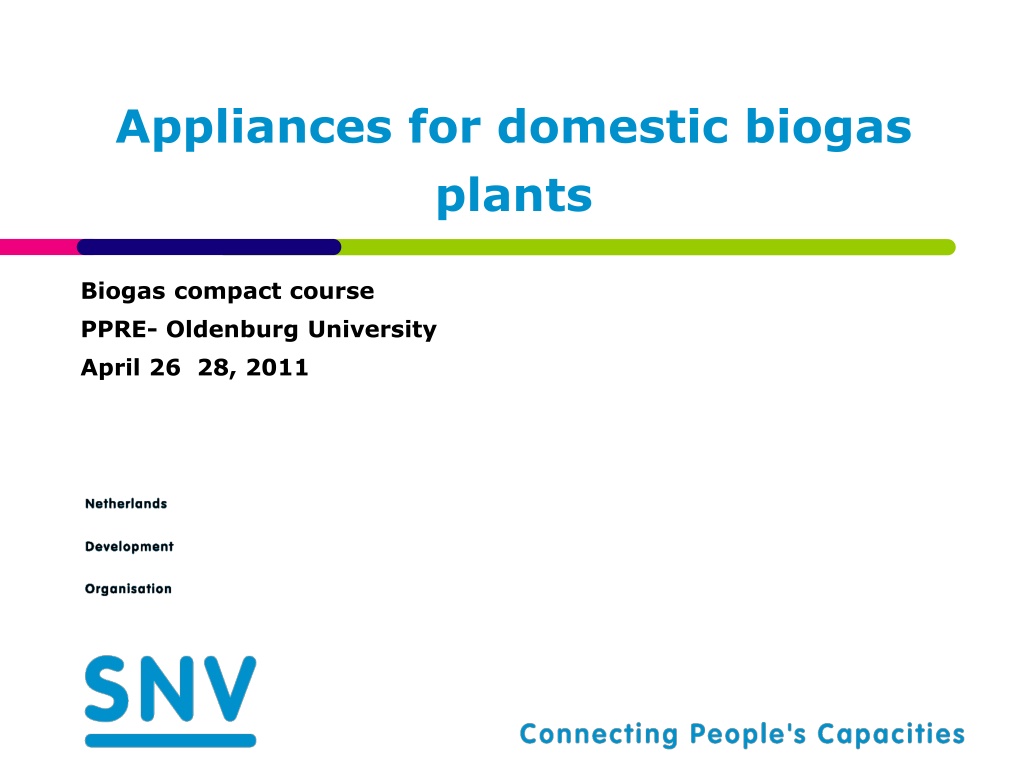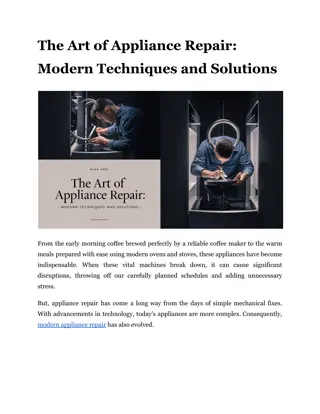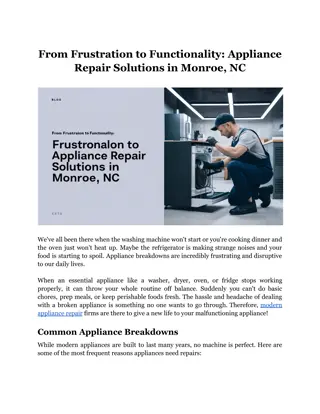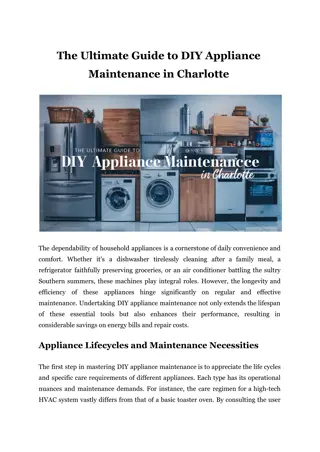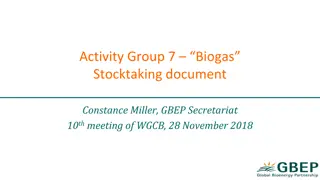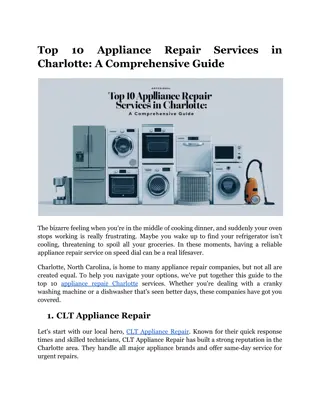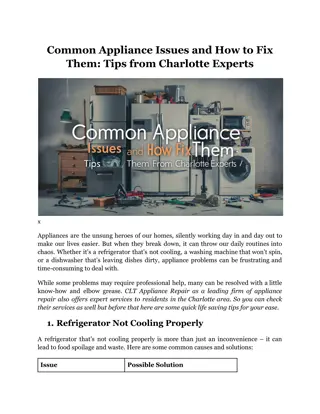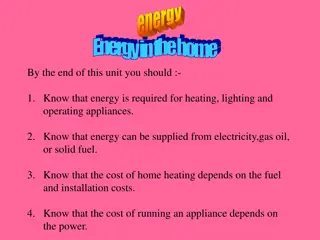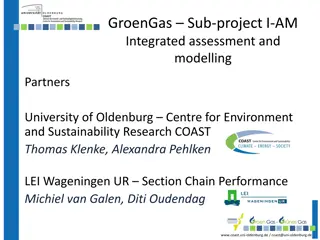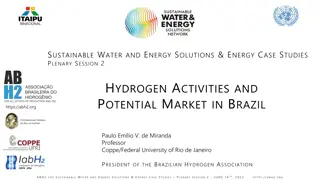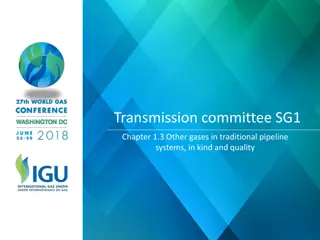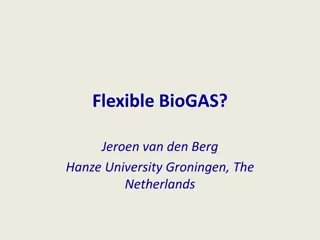Exploring Appliance Use in Domestic Biogas Plants
Delve into the world of household biogas plants with this presentation covering the design, advantages, and combustion process of biogas for cooking. Learn about the efficiency and benefits of utilizing biogas as an energy source for cooking and lighting in rural households, along with the key design criteria for stoves. Discover the convenience, financial savings, and health advantages associated with using biogas for household activities.
Download Presentation

Please find below an Image/Link to download the presentation.
The content on the website is provided AS IS for your information and personal use only. It may not be sold, licensed, or shared on other websites without obtaining consent from the author. Download presentation by click this link. If you encounter any issues during the download, it is possible that the publisher has removed the file from their server.
E N D
Presentation Transcript
Appliances for domestic biogas plants Biogas compact course PPRE- Oldenburg University April 26 28, 2011
Presentation Planning Household gas use Combustion process Stoves design criteria Lamps Importance of appliances Refer to the reader 3
Household gas use The average household biodigester is not suitable to run a electricity generator Biogas cannot be bottled It is an excellent energy source for cooking and lighting which accounts for more than 95% of rural domestic energy use 4
Advantages of biogas for cooking CONVENIENCE time-saving; wood collection and cleaning: Vietnam 1,5 to Nepal 6 h/d cooking faster; flame can be regulated; cooking can be done in up-right position; cooking can be easily done inside the house; FINANCE Saves money on energy sources HEALTH fine particles and CO: smoke world death-cause nr. 3 AIDS Malaria; 1.6 mln death per year safer, less chance for accidences like with open fire 6
Combustion process during cooking Primary air intake ~ 90%, secondary air 10% 5.7 volume air is required for 1 volume biogas for complete combustion Mix too rich: incomplete combustion, CO emission, less efficiency Mix too lean: too much air cools the flame, less efficiency Combustion speed 40cm/sec 8
Stove design Burner design criteria: Starting values: QR [kcal/h] = prescribed heat requirement VF [m3/h] = fuel flow rate H [m W.C.] = prescribed gas pressure Geometrical data: do [mm] d [mm] l [mm] = 2.1 * (VF/ h) (jet diameter) = 6 * do = 7 * d (diameter mixing pipe) (length of mixing) 10
Stove design considerations Efficiency > 55% User comfort (position of the tap, gas flow regulation capacity of the tap, primary air intake regulation) Stability of the frame, distance burner frame support Stability of the cooking vessel on the pan supports Distance bottom cooking vessel flame ports burner, 25 30 mm CO emissions Manufacturing simplicity, locally made preferably by various rural workshops Cost 11
Stove test results Name Burner Pan CO Flue Time to height PPM temp Boil (mins) Test 1 standard 32 mm 251 84 4.9 Test 2 lotus 32 mm 203 87 5.0 Test 3 lotus 39 mm 32 89 5.2 Test 4 standard 39 mm 286 82 4.8 13
Temperature Rise 110 Temperature Rise (C) 100 90 Test3 CO 32ppm Test4 CO 286ppm Test2 CO 203ppm Test1 CO 251ppm 80 70 60 50 40 30 0 100 200 300 400 Time (Seconds) 14
Stove testing under basic lab conditions Flue John Gas and temperature sensor Filter Stove Meter 15
Biogas stove standards ..\..\2010 Quality Management\03 QS Appliances\QS Appliances Text files\Biogas Stove Part 1.doc 20
Quality Quotes Good is not good where better is expected." -- Thomas Fuller The bitterness of poor quality lingers long after the sweetness of low price. If you think training is expensive...consider ignorance. Anonymous
Gas tap 26
Fuel matrix Fuel Unit Heat value Stove Efficiency Amount of kCal/Unit biogas eq Biogas m3 5,200 Gas stove 60 1 Straw Kg 3,300 Tripod stove 11 8.60 Wood Kg 3,800 Tripod stove 16 5.00 Charcoal Kg 6,900 Oven 28 1.62 Kerosene Litre 9,100 Oil stove 45 0.76 LPG m3 25,000* LPG stove 60 0.20 Electricity kWh 860 Electric 70 5.18 cooker 35
Current Developments In cooperation with the African and Lao biogas programmes the NBP in Cambodia has made a R&D contract with a mechanical development agency with the following objectives 1. Improvement of the present design biogas stove manufactured in Cambodia; 2. Development of a complete package of documentation and special tools required for the manufacturing of the improved stove, and; 3. Training package development for vocational trainers and workshop technicians on the 37 manufacturing of the stoves.
Benefits of applying biogas: light Capacity comparable with 60-75 W incandescent lamp CONVENIENCE Backup to unreliable electricity grid Replacement for costly- batteries, candles, kerosene, etc. Gives light where is used to be dark Low gas use, 80 100 liters/hour SAFER Reduces the risk of fire in the house when well positioned and care is take when the mantle needs to be replaced HOWEVER Poor efficiency of only 3% (Kerosene lamp 6%) Very high temperature is needed to glow 1,000-1,500 C Frequent change of mantle 40
Biogas lamps Will fulfill a demand for good quality light Difficult to be made by small scale workshops Cheap large scale production in China and India Need a good service infrastructure (regular need for spare- parts) Need quality user training for operation and maintenance 41
Lamp design China 1. Nozzle and injector 2. hanger 3. connecting piece 4. inlet for primary air 5. injector 6. nut 7. washer 8. upper cover 9. clay head 10.air vent 11.clip pin 12.reflector 13.glass cover 43
